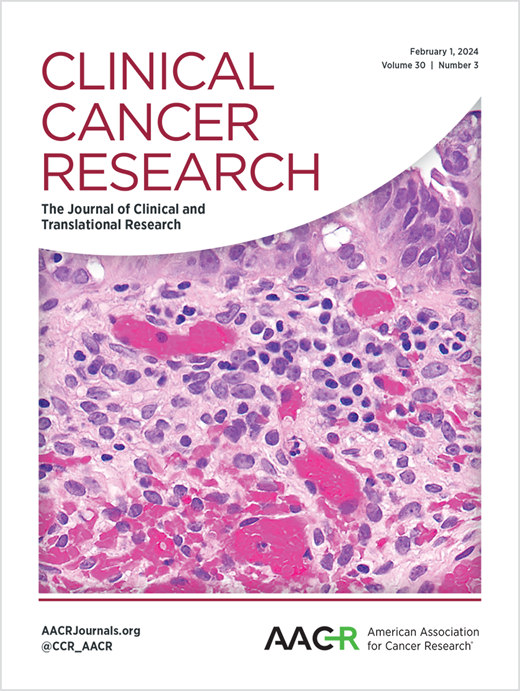Genomic landscape of circulating tumor DNA and real-world outcomes in advanced endometrial cancer.
IF 10
1区 医学
Q1 ONCOLOGY
引用次数: 0
Abstract
PURPOSE ctDNA is a novel technique extensively studied in solid tumors, although not currently well defined in endometrial cancer (EC). EXPERIMENTAL DESIGN A de-identified retrospective analysis of 1988 patients with advanced/recurrent EC was performed. In addition, an analysis of a real-world evidence (RWE) cohort was completed (n=1266). Patients underwent ctDNA testing using Guardant360 during routine clinical care. The objective was to describe and assess molecular landscape using ctDNA. RESULTS Among 1988 ctDNA samples, at least one somatic alteration was detected in 91.6% (n=1821). Most frequently altered genes were TP53 (64%), PIK3CA (29%), PTEN (25%), ARID1A (20%) and KRAS (14%). Overall, 18.5% had amplifications, with the majority identified in CCNE1 (40.9%), PIK3CA (22%) and EGFR (19.3%). From the RWE cohort, those with TP53 mutations had a worse overall survival (OS) vs those without TP53 mutations (p=0.02) and those with TP53 co-mutations had an inferior OS in comparison to TP53-mutated only (p=0.016). Amongst these, patients with a PIK3CA co-mutation (p=0.012) and CCNE1 amplification (p=0.01) had inferior OS compared to those with only TP53 mutations. 57 patients with newly diagnosed EC had at least 2 serial ctDNA samples showing evolution in detected variants compared to baseline samples, with TP53 being the most frequent change. CONCLUSIONS This study is one of the largest cohorts of ctDNA currently reported in EC. The presence of TP53 mutation and other co-mutations detected by ctDNA have a negative effect on outcomes. This report suggests that ctDNA analysis is feasible and could become a useful biomarker for EC.晚期子宫内膜癌循环肿瘤 DNA 的基因组图谱与实际治疗效果
目的ctDNA是一种新型技术,在实体瘤中得到了广泛研究,但目前在子宫内膜癌(EC)中还没有得到很好的定义。此外,还完成了一项真实世界证据(RWE)队列分析(n=1266)。患者在常规临床治疗期间使用 Guardant360 进行了 ctDNA 检测。结果在1988份ctDNA样本中,91.6%的样本(n=1821)至少检测到一个体细胞改变。最常发生改变的基因是 TP53(64%)、PIK3CA(29%)、PTEN(25%)、ARID1A(20%)和 KRAS(14%)。总体而言,18.5%的患者存在基因扩增,其中大部分被确定为CCNE1(40.9%)、PIK3CA(22%)和表皮生长因子受体(19.3%)。在RWE队列中,与无TP53突变者相比,有TP53突变者的总生存期(OS)较差(P=0.02),与仅有TP53突变者相比,有TP53共突变者的OS较差(P=0.016)。其中,与仅有TP53突变的患者相比,有PIK3CA共突变(p=0.012)和CCNE1扩增(p=0.01)的患者的OS较差。57名新诊断的EC患者至少有2份连续的ctDNA样本显示,与基线样本相比,检测到的变异发生了变化,其中TP53是最常见的变化。ctDNA检测到的TP53突变和其他共突变对预后有负面影响。该报告表明,ctDNA分析是可行的,可以成为治疗EC的有用生物标志物。
本文章由计算机程序翻译,如有差异,请以英文原文为准。
求助全文
约1分钟内获得全文
求助全文
来源期刊

Clinical Cancer Research
医学-肿瘤学
CiteScore
20.10
自引率
1.70%
发文量
1207
审稿时长
2.1 months
期刊介绍:
Clinical Cancer Research is a journal focusing on groundbreaking research in cancer, specifically in the areas where the laboratory and the clinic intersect. Our primary interest lies in clinical trials that investigate novel treatments, accompanied by research on pharmacology, molecular alterations, and biomarkers that can predict response or resistance to these treatments. Furthermore, we prioritize laboratory and animal studies that explore new drugs and targeted agents with the potential to advance to clinical trials. We also encourage research on targetable mechanisms of cancer development, progression, and metastasis.
 求助内容:
求助内容: 应助结果提醒方式:
应助结果提醒方式:


